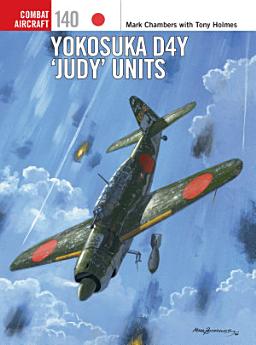Yokosuka D4Y 'Judy' Units
sept 2021 · Combat Aircraft Libro 140 · Bloomsbury Publishing
Libro electrónico
96
Páginas
reportLas calificaciones y opiniones no están verificadas. Más información
Acerca de este libro electrónico
In 1938, the Yokosuka Naval Air Technical Arsenal, acting under the requirements issued by the Kaigun Koku Hombu for a Navy Experimental 13-Shi Carrier Borne specification for a dive-bomber to replace the venerable 'Val' aboard carriers. The resulting D4Y Suisei ('Comet'), codenamed 'Judy' by the Allies, was initially powered by a licence-built German Daimler-Benz DB 601 inline engine as used in the Bf 109E. Despite making an inauspicious combat debut during the Battle of Midway in June 1942, the 'Judy' eventually proved to be an important asset for the IJNAF during battles in the latter years of the Pacific War. Its great successes resulted in the sinking of the escort carrier USS Princeton in an early kamikaze attack of the Philippines and the near sinking of the fleet carrier USS Franklin in a dive-bombing attack off Japan.
While the Judy had an impressive top-speed, like its predecessor, and many other Japanese military aircraft, it possessed design shortcomings including inadequate armour protection for its aircrew and no self-sealing fuel tanks. As a result, when pitted against new, advanced US Navy fighters suffered horrendous losses.
During the final months of World War 2 it became apparent that there would be no Japanese victory. Acting out of desperation, the IJNAF employed the 'Judy' in the dreaded kamikaze role, in which it excelled due to its high-speed characteristics. Most notably, the D4Y mounted one of the last combat actions of World War 2 when a flight of 11 Judies, personally led by the instigator of the suicide attacks, Vice Admiral Matome Ugaki, took off on a 'search mission' on August 15, 1945. This volume chronicles the action-packed wartime exploits of Japan's finest dive-bomber of World War 2.
While the Judy had an impressive top-speed, like its predecessor, and many other Japanese military aircraft, it possessed design shortcomings including inadequate armour protection for its aircrew and no self-sealing fuel tanks. As a result, when pitted against new, advanced US Navy fighters suffered horrendous losses.
During the final months of World War 2 it became apparent that there would be no Japanese victory. Acting out of desperation, the IJNAF employed the 'Judy' in the dreaded kamikaze role, in which it excelled due to its high-speed characteristics. Most notably, the D4Y mounted one of the last combat actions of World War 2 when a flight of 11 Judies, personally led by the instigator of the suicide attacks, Vice Admiral Matome Ugaki, took off on a 'search mission' on August 15, 1945. This volume chronicles the action-packed wartime exploits of Japan's finest dive-bomber of World War 2.
Acerca del autor
Mark Chambers is an avid World War 2 aviation enthusiast and aviation history author. He has studied World War 2 military aviation, with a keen interest in the air war in the Pacific, extensively. He is the author of Osprey Publishing's Combat Aircraft: Nakajima B5N 'Kate' and B6N 'Jill' Units (2017) and General Aviation: Wings of the Rising Sun: Uncovering the Secrets of Japanese Fighters and Bombers of World War II (2018). Mark works as a technical writer for Huntington Ingalls Industries/Newport News Shipbuilding in Newport News, Virginia.
Jim Laurier is a native of New England, growing up in New Hampshire and Massachusetts. He has been drawing since he could hold a pencil and throughout his life he has worked in many mediums creating artwork on a variety of subjects. He has worked on the Osprey Aviation list since 2000, and in that time he has produced some of the finest artwork seen in these volumes.
Jim Laurier is a native of New England, growing up in New Hampshire and Massachusetts. He has been drawing since he could hold a pencil and throughout his life he has worked in many mediums creating artwork on a variety of subjects. He has worked on the Osprey Aviation list since 2000, and in that time he has produced some of the finest artwork seen in these volumes.
Califica este libro electrónico
Cuéntanos lo que piensas.
Información de lectura
Smartphones y tablets
Instala la app de Google Play Libros para Android y iPad/iPhone. Como se sincroniza de manera automática con tu cuenta, te permite leer en línea o sin conexión en cualquier lugar.
Laptops y computadoras
Para escuchar audiolibros adquiridos en Google Play, usa el navegador web de tu computadora.
Lectores electrónicos y otros dispositivos
Para leer en dispositivos de tinta electrónica, como los lectores de libros electrónicos Kobo, deberás descargar un archivo y transferirlo a tu dispositivo. Sigue las instrucciones detalladas que aparecen en el Centro de ayuda para transferir los archivos a lectores de libros electrónicos compatibles.











